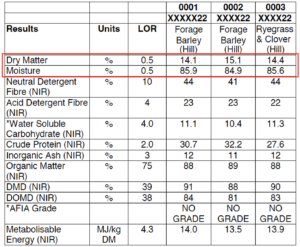It’s always surprising how each season brings with it new challenges and learning opportunities. The last three years, being somewhat reminiscent of a typical English autumn, have offered almost as many learning opportunities as buckets of rain.
One such learning from the past few years, was that, although rainfall drives pasture growth, too much rainfall can cause pastures to become waterlogged and significantly reduce their value as feed.
Why are wet pastures low value feed?
Pasture value is calculated on a dry matter (DM) basis, where the water component of the pasture is discounted. For instance, a highly digestible lush ryegrass / clover mix in a normal season would have a DM of around 20%, meaning an 80% water content. However, throughout 2022, plant tissue tests were commonly recording DM’s of between 10 and 15% (see figure 1).

How does the water content of pastures decrease the feed value?
An increase in the water content of pastures significantly reduces the concentration of protein, energy, and minerals within the pasture. For example, a pasture with a 20% DM becoming 10% DM essentially halves in nutritional value on a ‘fresh-matter basis’, seeing livestock lose condition whilst grazing what is believed to be highly productive feed.
So, an animal needs to consume double the volume of 10% DM feed to achieve the same level of nutrition as the same feed at 20% DM.
Furthermore, high water-content pasture takes longer to digest, making the animal feel full for longer, essentially reducing feed consumption.
How can we overcome the impact of wet pastures?
Energy and protein requirements can somewhat be corrected by feeding high quality hay or grain in conjunction with grazing the pasture. However, this will have little impact on minerals and the livestock will grow increasingly deficient in major minerals like calcium, magnesium and sodium.
If you have not offered your animals a mineral supplement in 2023, ANP recommend offering them a basic supplement mix of magnesium oxide, lime and salt (StockMins-CLS) or at the very least give them access to salt blocks to top up major minerals.
This is especially important before offering them a targeted and more costly supplement which they would likely overconsume to satisfy short-term salt, magnesium and calcium deficiencies.